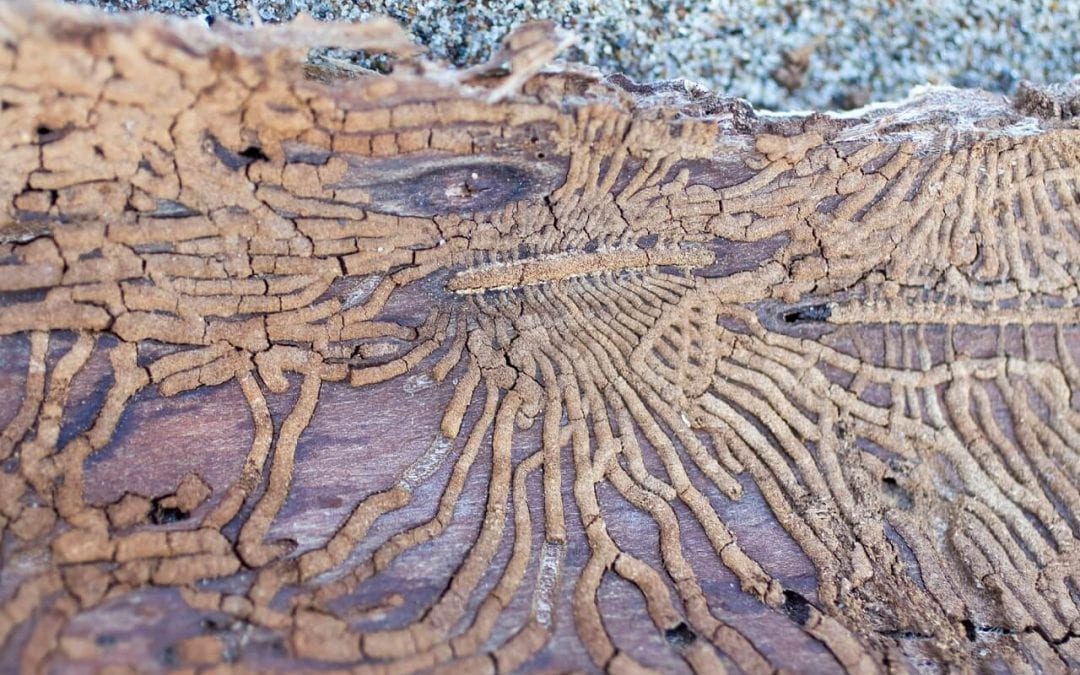It’s important to know the warning signs of termites and how to identify termite tunnels in wood because a termite infestation can cause serious structural damage that is costly to repair. To prevent termite damage, familiarize yourself with these 5 signs of termites in your home and learn how to find evidence of termites. You also want to be proactive about termite control because often times this kind of damage is not covered by your home insurance. Proper precautions and maintenance are important to prevent larger problems down the road.
1. Flying Insects and Shed Wings
Once the last freeze of winter has passed, you might start to see swarms of winged termites. These are termites that are ready to mate and swarm in search of a new place to set up their budding colony.
Some species swarm at night and are attracted to light sources. Other species may swarm in daylight, but all drywood termites tend to swarm after it rains and during specific times of the year. Other species will swarm in daylight, but all drywood termites tend to swarm after rain at particular times of the year.
Termites will lose their wings once they have found a mate. They will then crawl to a nest to start a new colony. Because of this you will often see piles of discarded wings and winged termites in your home are often one of the first visible signs of a colony in or around your home. Keep an eye out for wings around your window sills and doors.
2. Warped Paint or Varnish
Termites in your home may cause visible signs of their presence like warped varnish or what some call termite paint on surfaces where they’ve chewed through the wood. You may find wood damage below and behind walls, under floors and more. Termites eat wood in search of cellulose and often leave behind grooves that over time weaken the wood. This can cause substantial structural damage to your home. Hollowed wood will have an empty sound and a honeycomb interior. This will cause moisture build up in the hollow spaces that are created. Wood damage can be found below and behind surfaces like walls, floors and more.
Of course, if you can see the tunnels themselves, then you’ve got a surefire sign of termites. However, if you see odd signs of water damage without finding any leaks, then there may be excess moisture in termite tunnels, hidden out of sight.
3. Termites in Your Home Cause Brittle, Papery-Feeling Wood
Drywood termites consume wood starting on the inside and moving out. They will therefore leave a thin veneer of wood, or even just the paint. The tunnels that termite workers chew through wood weaken the structure, and you can often see evidence of termites after a few quick checks even if you can’t see the difference from the surface. For example, if you rap your knuckles against your baseboards and the sound is hollow, then termites have probably gnawed away a significant portion of the wood.
You will often hear stories where a termite infestation is found when a vacuum cleaner goes through a floor board or where someone was pressing on a door frame and their finger went right through it.
4. Tapping and Chewing Sounds of Termites in Your Home
Did you ever wonder what a termite sounds like? One other evidence of termites in your home is when you can actually hear them. Soldier termites knock their heads against the wood to communicate with one another. If you listen carefully, you might be able to hear this tapping sound for yourself.
Worker termites are also surprisingly noisy when they eat, meaning that you can probably hear them chewing tunnels in wood if you put your ear up close to an infested piece of wood.
If you put your ear close to infested wood, you might be able to hear them munching away. This was even mentioned over 2,000 years ago by the Roman writer Pliny the elder! A recent study even showed that the eating habits of termites found that these insects work faster when they hear rock music! It would be amusing if they weren’t so detrimental to your home!
5. White ants
Many people confuse termites with white ants. This is an easy mistake to make because they are similar in size and shape – and usually even behavior. There are some differences, however, and the biggest giveaway is that there is no such thing as a white ant! if you think you saw a white ant, this is a sure sign you may have a termite problem on your hands. Here are some other things to look out for:
- Termites are light in color, almost translucent.
- The antennas of ants are bent, while termite antennas are straight.
- A termite’s wings are both the same size, while an ant has one set larger than the other.
6. Tight fitting doors and hard-to-open windows
Termites create a moisture when they are eating and tunneling through door and window frames. This moisture sometimes causes the wood to warp therefore making it tough to open doors and windows. You may attribute this to damp and hot weather, but sometimes it could be a sigh of a bigger problem.
7. Mud Tubes and Frass are Signs of Termites in Your Home
To further investigate whether you have evidence of termites, step outside and look around the foundation of your home. If you can spot mud tubes around the base of your house, then you’re seeing evidence of subterranean termites. Pencil-sized mud tubes can be found wherever the ground meets your house. They can also be found near food sources like trees. The reason for this is that termites nest underground and forage up to their food source – often being your home. These tunnels help block out cool, dry air which effectively turns your home into a very safe, cozy environment!
Another telling sign of termites is seeing their droppings or frass. If you find piles of little wood-colored pellets, then you’re looking at what used to be part of your home.
Termite colonies and termite tunnels in wood in your home can quickly spiral into a destructive infestation if left untreated. Keep a vigilant eye out for any signs of termites in your home like warped paint, brittle, papery wood, mud tubes, and frass. Look for visible swarms of flying termites and listen for audible chewing. If these signs are present in your home, contact a termite inspector immediately.
Sunrise Home Inspection offers wood-destroying organism inspections and other home inspection services. Contact us to schedule an appointment in Eastern Connecticut and Western Rhode Island.

